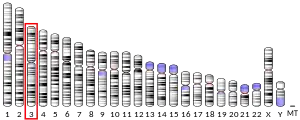Contactin 3
Contactin-3 is a protein that in humans is encoded by the CNTN3 gene.[5][6][7]
| CNTN3 | |||||||||||||||||||||||||||||||||||||||||||||||||||
|---|---|---|---|---|---|---|---|---|---|---|---|---|---|---|---|---|---|---|---|---|---|---|---|---|---|---|---|---|---|---|---|---|---|---|---|---|---|---|---|---|---|---|---|---|---|---|---|---|---|---|---|
 | |||||||||||||||||||||||||||||||||||||||||||||||||||
| |||||||||||||||||||||||||||||||||||||||||||||||||||
| Identifiers | |||||||||||||||||||||||||||||||||||||||||||||||||||
| Aliases | CNTN3, BIG-1, PANG, PCS, contactin 3 | ||||||||||||||||||||||||||||||||||||||||||||||||||
| External IDs | OMIM: 601325 MGI: 99534 HomoloGene: 7461 GeneCards: CNTN3 | ||||||||||||||||||||||||||||||||||||||||||||||||||
| |||||||||||||||||||||||||||||||||||||||||||||||||||
| |||||||||||||||||||||||||||||||||||||||||||||||||||
| |||||||||||||||||||||||||||||||||||||||||||||||||||
| |||||||||||||||||||||||||||||||||||||||||||||||||||
| Wikidata | |||||||||||||||||||||||||||||||||||||||||||||||||||
| |||||||||||||||||||||||||||||||||||||||||||||||||||
References
- GRCh38: Ensembl release 89: ENSG00000113805 - Ensembl, May 2017
- GRCm38: Ensembl release 89: ENSMUSG00000030075 - Ensembl, May 2017
- "Human PubMed Reference:". National Center for Biotechnology Information, U.S. National Library of Medicine.
- "Mouse PubMed Reference:". National Center for Biotechnology Information, U.S. National Library of Medicine.
- Mock BA, Connelly MA, McBride OW, Kozak CA, Marcu KB (Feb 1997). "Plasmacytoma-associated neuronal glycoprotein, Pang, maps to mouse chromosome 6 and human chromosome 3". Genomics. 34 (2): 226–8. doi:10.1006/geno.1996.0271. PMID 8661054.
- Yoshihara Y, Kawasaki M, Tamada A, Nagata S, Kagamiyama H, Mori K (Mar 1996). "Overlapping and differential expression of BIG-2, BIG-1, TAG-1, and F3: four members of an axon-associated cell adhesion molecule subgroup of the immunoglobulin superfamily". J Neurobiol. 28 (1): 51–69. doi:10.1002/neu.480280106. PMID 8586965.
- "Entrez Gene: CNTN3 contactin 3 (plasmacytoma associated)".
External links
- Human CNTN3 genome location and CNTN3 gene details page in the UCSC Genome Browser.
Further reading
- Muzny DM, Scherer SE, Kaul R, et al. (2006). "The DNA sequence, annotation and analysis of human chromosome 3". Nature. 440 (7088): 1194–8. Bibcode:2006Natur.440.1194M. doi:10.1038/nature04728. PMID 16641997.
- Liu T, Qian WJ, Gritsenko MA, et al. (2006). "Human plasma N-glycoproteome analysis by immunoaffinity subtraction, hydrazide chemistry, and mass spectrometry". J. Proteome Res. 4 (6): 2070–80. doi:10.1021/pr0502065. PMC 1850943. PMID 16335952.
- Ota T, Suzuki Y, Nishikawa T, et al. (2004). "Complete sequencing and characterization of 21,243 full-length human cDNAs". Nat. Genet. 36 (1): 40–5. doi:10.1038/ng1285. PMID 14702039.
- Kamei Y, Takeda Y, Teramoto K, et al. (2001). "Human NB-2 of the contactin subgroup molecules: chromosomal localization of the gene (CNTN5) and distinct expression pattern from other subgroup members". Genomics. 69 (1): 113–9. doi:10.1006/geno.2000.6310. PMID 11013081.
- Nagase T, Kikuno R, Ishikawa K, et al. (2000). "Prediction of the coding sequences of unidentified human genes. XVII. The complete sequences of 100 new cDNA clones from brain which code for large proteins in vitro". DNA Res. 7 (2): 143–50. doi:10.1093/dnares/7.2.143. PMID 10819331.
- Connelly MA, Grady RC, Mushinski JF, Marcu KB (1994). "PANG, a gene encoding a neuronal glycoprotein, is ectopically activated by intracisternal A-type particle long terminal repeats in murine plasmacytomas". Proc. Natl. Acad. Sci. U.S.A. 91 (4): 1337–41. Bibcode:1994PNAS...91.1337C. doi:10.1073/pnas.91.4.1337. PMC 43153. PMID 8108413.
This article is issued from Wikipedia. The text is licensed under Creative Commons - Attribution - Sharealike. Additional terms may apply for the media files.





